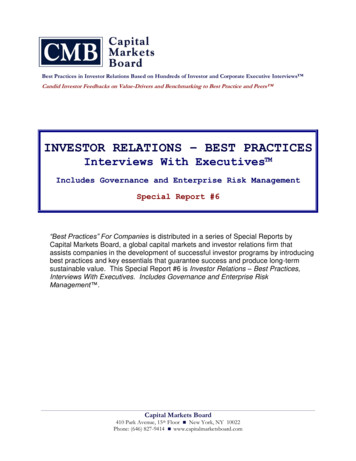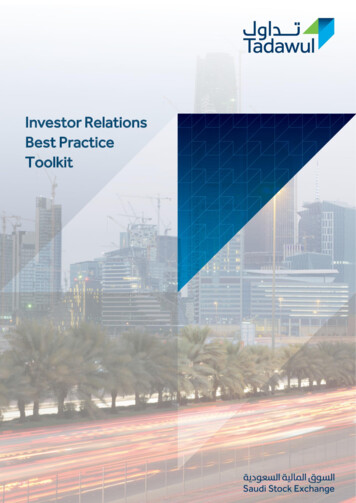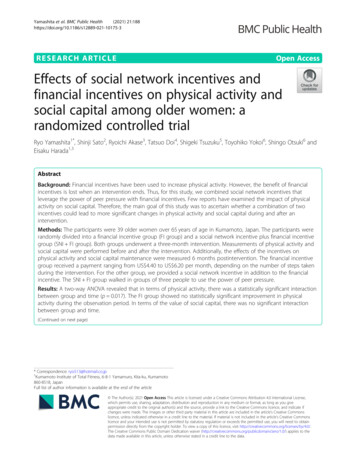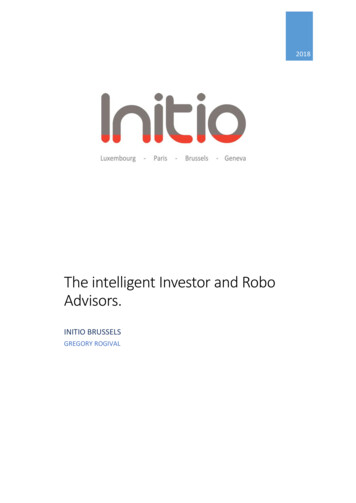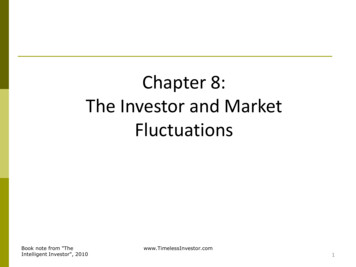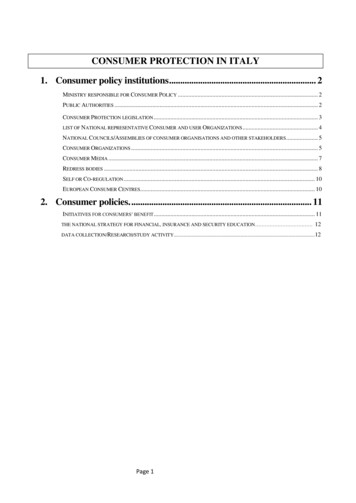
Transcription
When Investor Incentives and ConsumerInterests Diverge: Private Equity in HigherEducationSabrina T. HowellStern School of Business, New York UniversityConstantine YannelisBooth School of Business, University of ChicagoWe study how private equity buyouts create value in higher education, a sector with opaqueproduct quality and intense government subsidy. With novel data on 88 private equitydeals involving 994 schools, we show that buyouts lead to higher tuition and per-studentdebt. Exploiting loan limit increases, we find that private equity-owned schools bettercapture government aid. After buyouts, we observe lower education inputs, graduationrates, loan repayment rates, and earnings among graduates. Neither school selection norstudent body changes fully explain the results. The results indicate that in a subsidizedindustry, maximizing value may not improve consumer outcomes. (JEL I22, I23, G34,G38))Received October 15, 2018; editorial decision July 24, 2019 by Editor Francesca Cornelli.Authors have furnished an Internet Appendix, which is available on the Oxford UniversityPress Web site next to the link to the final published paper online.We are grateful to discussants Pierre Azoulay, Michael Ewens, Jonah Rockoff, and Richard Thakor and also forcomments from Raji Chakrabarti, Francesca Cornelli, David Deming, Michael Dinerstein, Michael Ewens,Caroline Hoxby, Will Gornall, Arpit Gupta, Justine Hastings, Steve Kaplan, Larry Katz, Theresa Kuchler,Alexander Ljungqvist, Holger Mueller, Thomas Philippon, Larry Schmidt, Antoinette Schoar, Albert Sheen,Doug Staiger, Lesley Turner, Jeff Wurgler, and David Yermack and seminar participants at the NBER LaborStudies and Education Summer Institute, MIT Sloan, Harvard Business School, Yale School of Management,Berkeley Haas School of Business, The Federal Reserve Bank of New York, the NBER Entrepreneurship meeting,the FMA Napa Conference, the SFS Cavalcade, and NYU Stern. We are also grateful to Suzanne Chang,Dalya Elmalt, and Katerina Nikalexi for superb research assistance. Sabrina Howell thanks the Kauffmanfoundation for financial support and the Stern Infrastructure Initiative for Preqin data. Constantine Yannelisthanks the Fama-Miller Center and the Becker Friedman Institute for financial support. Supplementary data canbe found on The Review of Financial Studies web site. Send correspondence to Sabrina Howell, Stern School ofBusiness, New York University, 44 West 4th Street, New York, NY 10012; telephone: (212) 998-0719. E-mail:sabrina.howell@nyu.edu.The Review of Financial Studies 33 (2020) 4024–4060 The Author(s) 2019. Published by Oxford University Press on behalf of The Society for Financial Studies.All rights reserved. For permissions, please e-mail: 9Advance Access publication October 22, 2019[08:30 31/7/2020 RFS-OP-REVF190136.tex]Page: 40244024–4060Downloaded from 2331 by University of California, Berkeley/LBL user on 10 April 2021Charlie EatonUniversity of California, Merced
Private Equity in Higher Education1 See also Cao and Lerner (2009), Guo, Hotchkiss, and Song (2011), and Bernstein, Lerner, and Mezzanotti (2017).2 Fund managers can increase value though operational changes because buyout contracts give them substantialcontrol rights over the firm. Private equity contracts are complex and state contingent, usually giving the investorsubstantial control rights (Lerner and Schoar 2005). For overviews, see Kaplan and Strömberg (2009) and Metrickand Yasuda (2010).4025[08:30 31/7/2020 RFS-OP-REVF190136.tex]Page: 40254024–4060Downloaded from 2331 by University of California, Berkeley/LBL user on 10 April 2021Private equity buyouts are known to increase firm value (Kaplan 1989; Boucly,Sraer, and Thesmar 2011; Davis et al. 2014).1 How they create value maydiffer across industries in ways that have important implications for target firmstakeholders. Prior work has identified at least three mechanisms through whichprivate equity buyouts increase firm value: (1) reducing financial constraints(Boucly, Sraer, and Thesmar 2011); (2) improving operational efficiency (Daviset al. 2014, Bernstein and Sheen 2016); and (3) adopting information technology(Agrawal and Tambe 2016).2 Shleifer and Summers (1988) identify a fourthpotential mechanism in the context of hostile takeovers: the breach of implicitcontracts with stakeholders. In competitive industries where incentives arealigned between stakeholders, the first three mechanisms enable private equitybuyouts to create value for both consumers and equity holders, as Bernstein andSheen (2016) and Fracassi, Previtero, and Sheen (2017) find in the case of fastfood restaurants and big box retail stores. Conversely, in sectors with intensivegovernment subsidy and opaque product quality, value for equity holders maycome at the expense of consumers as a result of the fourth mechanism.We study private equity buyouts in postsecondary education, whereinformation frictions combined with government loan guarantees and directsubsidies contribute to incentive misalignment among stakeholders. Weexamine value creation and its consequences among three stakeholders: equityholders, taxpayers, and consumers. Proxies for value creation from the equityholder perspective include enrollment and profits. Proxies for value creation forthe government (taxpayers) and for consumers (students) include graduationrates, earnings, loan burdens and repayment rates, and tuition. We show thatprivate equity buyouts positively affect proxies for firm value and find resultsconsistent with the three established mechanisms. We also show that the buyoutslead to greater capture of government aid and deteriorating student outcomes,consistent with implicit contract violation.We employ novel data on 88 deals in which private equity firms acquireindependent, privately owned schools. These deals are associated with 557school-level ownership changes, of which 218 occur after the deal throughacquisitions. Private equity-owned school systems establish an additional 437new schools. Using regressions with school and year fixed effects as well as amatching estimator, we confirm findings from the existing literature that privateequity ownership leads to higher profits; in our data, profits triple after a buyout.Existing literature has also found better management among private equityowned firms (Muscarella and Vetsuypens 1990; Bloom, Sadun, and Van Reenen2015; Cornelli and Karakaş 2015; Cohn, Nestoriak, and Wardlaw 2017).
The Review of Financial Studies / v 33 n 9 20204026[08:30 31/7/2020 RFS-OP-REVF190136.tex]Page: 40264024–4060Downloaded from 2331 by University of California, Berkeley/LBL user on 10 April 2021In line with the new management channel, we find that chief executive turnoverincreases after a buyout by around 50%.The higher revenue that we observe comes partly from a 1,600 increasein tuition, approximately half the average total tuition at community colleges.It also comes from almost 50% higher enrollment. Reliance on federal aidincreases after private equity buyouts and approaches the 90% of revenuethreshold that is the statutory limit. Per-student borrowing and per-studentfederal grants increase by about 12% and 14% of their respective means.We exploit a 2007 student loan borrowing limit expansion to test whetherprivate equity-owned schools are more responsive to changes in federal loanguarantees. Relative to other institutions, private equity-owned schools respondto the limit increase by raising tuition faster than other for-profit schools,which induces higher levels of borrowing. Superior capture of governmentaid is thus a channel through which high-powered incentives of private equityownership translate to higher profits. This is a rent-seeking phenomenon andnot in students’ or taxpayers’ interest.We find sharp declines in student graduation rates, loan repayment rates,and labor market earnings after private equity buyouts (the declines are 13%,5.6%, and 5.8% of their respective means). Enhanced recruiting and reducedinstructional quality can reconcile the otherwise puzzling combination of higherenrollment despite higher tuition and deteriorating student outcomes. Privateequity-owned schools have twice the share of employees in sales as do otherfor-profit schools. We show that education inputs, including the ratio of facultyto students and the share of spending devoted to instruction, decline afterbuyouts. Transitions to online education could produce declines in facultyratios. Online education could both reduce transportation costs for studentsand enable economies of scale for the school. However, we find a small effectof buyouts on the propensity of a school to become primarily online and noeffects on the share of distance students, and the effects on student outcomesare not attenuated when online schools are omitted from the sample.Private equity buyouts may lead to changed operations that are detrimentalto student success. There are two obvious alternative explanations. One is aselection mechanism, in which private equity firms are skilled at selectingtargets on trajectories to the changes we observe. For all outcomes, we showvisual event studies among switcher-schools around the buyout year. Thesereveal discontinuous breaks in outcomes and sharp changes to trends aroundthe buyout year. There are no meaningful observable pre-trends. Private equityfirms clearly do not acquire schools at random, but this visual evidence indicatesthat a selection mechanism is unlikely to fully explain the changes we observeafter buyouts.The second alternative channel is student composition. Students who attendafter the buyout may be less prepared than those who attended before. Thischannel has ambiguous implications for student welfare and depends on schoolvalue-added, which we do not directly observe. To hold any composition effects
Private Equity in Higher Education3 See Deming et al. (2012), Liu and Belfield (2014), Cellini and Chaudhary (2014), Cellini and Turner (2016),Deming et al. (2016), and Armona, Chakrabarti, and Lovenheim (2017).4 For example, see Arcidiacono et al. (2014, 2016), Hastings et al. (2017), Stinebrickner and Stinebrickner (2013),and Wiswall and Zafar (2014), and . This literature has found that students from low-income backgrounds areparticularly prone to overestimating the earnings of past graduates in their major and institution and that studentswho are overly optimistic about their earnings and academic ability are particularly prone to dropping out.5 Based on Pitchbook data between 2010 and 2018; see pe-breakdown and wn-year-for-take-private-buyouts.4027[08:30 31/7/2020 RFS-OP-REVF190136.tex]Page: 40274024–4060Downloaded from 2331 by University of California, Berkeley/LBL user on 10 April 2021fixed, we use partially treated cohorts. These are students in 2-year programswho are already enrolled before a buyout occurs but have at least 1 year at thenow private equity-owned school. For graduation and loan repayment rates,we compare the cohort with partial treatment to the previous one with notreatment. Partially treated cohorts experience more than half the negative effecton graduation rates and the full effect on repayments rates of fully treatedcohorts. This does not reflect the elimination of degree programs after thebuyout, a possible short-term channel. We cannot rule out that the mechanismin the cohort analysis is different from the primary longer term effect, but thecohort analysis strongly suggests that composition does not explain our mainresults.Whether additional students enrolled as a result of post-buyout expansionare better or worse off depends in part on their outside option. A large literaturefinds that the expected labor market returns to for-profit education are lowerthan the returns to nonselective community college.3 If the students who wouldotherwise have attended community colleges are the source of expansion, thenew students are unlikely to be better off. Indeed, we find suggestive evidencethat a new private equity-owned school in a commuting zone siphons studentenrollment growth from community colleges. Consistent with this finding,Cellini, Darolia, and Turner (2017) show that community colleges and forprofit schools are direct substitutes. Substitution toward a school with lowerreturns is not as surprising as it may seem. In addition to for-profits using muchmore sophisticated and aggressive marketing, college students are known to bepoor forecasters of their future earnings.4The evidence against composition and selection channels does not allow usto rule out that mechanisms besides reduced quality (evidenced by declinesin instructional support) explain the negative effects on student outcomes.However, the results offer substantial evidence consistent with private equityownership leading to implicit contract violations. An important further pieceof evidence is that we find dramatic increases in law enforcement actions afterbuyouts, most of which stem from accusations that the school violated recruitingrules, such as quotas for sales staff, and misrepresentations of student loanterms, graduation rates, and student employment outcomes.Our results shed light on how private equity creates value. This is anespecially interesting question in the context of private-to-private transactions,which make up over 90% of private equity deal value and 99% of volume.5
The Review of Financial Studies / v 33 n 9 20206 Reducing expenditures on instruction is a well-established cause of lower graduation rates (Bound and Turner2007; Webber and Ehrenberg 2010).4028[08:30 31/7/2020 RFS-OP-REVF190136.tex]Page: 40284024–4060Downloaded from 2331 by University of California, Berkeley/LBL user on 10 April 2021When a private equity investor takes a public firm private, agency conflictsdecline as control becomes more tightly bound to ownership (Jensen 1989).The mechanisms may be more nuanced in a private-to-private transaction.Compared to the preexisting, private owners, private equity owners havehigher-powered incentives to maximize firm value because fund managers arecompensated through a call option-like share of the profits, employ substantialamounts of leverage, usually aim to liquidate investments within a short timeframe, and do not have existing relationships with target firm stakeholders.Private equity is often treated as a monolith, either praised for creating valueor maligned for supposed “strip and flip” strategies. Together, the existingliterature and our results suggest that there is important heterogeneity. Whenincentives between investors and consumers are aligned, quality improvementsshould accompany firm value creation (Hart, Shleifer, and Vishny 1997). Incontrast, for-profit colleges feature severe information frictions and misalignedincentives. There is low price elasticity of demand, in part because tuitionis not salient; students often enroll with zero up-front costs. Educationquality is extremely opaque, allowing for reducing instructional resourceswhile pursuing misleading marketing and recruiting strategies. The for-profittarget population is vulnerable to these approaches because it is extremelysocioeconomically disadvantaged (Deming, Goldin, and Katz 2012). Whiledropouts may increase when instructional resources decline, rolling admissionsenable rapid enrollment of new students. The required recruiting expenditures,especially with new sales technology adoption, may be lower than the costof retaining existing students.6 The sector also features intensive governmentsubsidy, separating revenue from the consumer. In particular, the expansion offederal student loan programs since the early 1990s created opportunities toincrease firm value through implicit contract violations.As a new owner, the private equity investor may be well-positioned totake advantage of these opportunities for value creation. In order to establishthe school, previous owners may have had to commit to implicit contractswith stakeholders; in exchange for government revenue, they would providea valuable education. Previous owners may have been unable or unwilling totake advantage of new opportunities for value creation that would have requiredviolating these implicit contracts. In fact, the potential profit from implicitcontract violation is one reason nonprofit ownership is prevalent in settingssuch as health care and education, where consumers depend on complex, longterm, implicit contracts with service providers (Hansmann 1980). Glaeser andShleifer (2001) discuss how in such settings, weaker incentives to maximizeprofits or increase value for investors can make nonprofit status optimal. Thismechanism requires consumers to rationally choose nonprofit firms over forprofit ones. It may be infeasible for consumers to make this choice when
Private Equity in Higher Education1. Data and Descriptive StatisticsThis section first describes the for-profit higher eduction industry and explainswhy it may feature incentive misalignment (Section 1.1). We both describeprivate equity’s role in the industry and also introduce our private equity dealdata in Section 1.2. We summarize the data from the Department of Educationon schools and students in Section 1.3.1.1 Institutional contextFor-profit schools (for-profits) have existed in the United States since theearly 1900s, but enrollment substantially grew in recent decades (left graph7 See Looney and Yannelis (2015), Bleemer et al. (2017), Krishnan and Wang (2017), and Mueller and Yannelis(2019).8 See Figure OB1 (in the Online Appendix). The health care economics literature examines how incentives and theownership of health care providers affect the price and quality of care. However, private equity within this settinghas not been studied. Providers appear to be motivated by incentives; however, results regarding ownership aremixed (Dafny et al. 2016; Duggan 2000; Clemens and Gottlieb 2014; Adelino, Lewellen, and Sundaram 2015;Sloan et al. 2001; Hackmann and Pohl 2018).4029[08:30 31/7/2020 RFS-OP-REVF190136.tex]Page: 40294024–4060Downloaded from 2331 by University of California, Berkeley/LBL user on 10 April 2021subsidy separates revenue from the consumer and quality is hard to observe.In our context, it seems likely that improved subsidy design could better alignincentives. This might be one avenue toward addressing the growth in federallyguaranteed student debt—which increased from 241 billion in 2003 to 1.6trillion in 2019—and possible accompanying adverse effects, including highlevels of default and reduced entrepreneurship.7A caveat of our analysis is worth mentioning. Private equity ownership is notrandomly assigned to schools, and it is impossible for researchers to observeall possible outcomes. We cannot entirely rule out that changes in student bodycomposition affect our results, or that the expansion of online education benefitsmany students. Additionally, while we observe sharp breaks for many outcomesaround the buyout, it is possible that private equity firms time buyouts to,for example, periods in which schools would experience sharply deterioratingstudent outcomes for other reasons.Our paper contributes to the literature on private equity and the real effectsof acquisitions, including Brown, Gredil, and Kaplan (2013), Ewens, RhodesKropf, and Strebulaev (2016), and Ma, Ouimet, and Simintzi (2018). Inaddition to Bernstein and Sheen (2016), two papers offer insights relatedto ours. Matsa (2011) shows that highly levered supermarket firms, whichsometimes become highly levered through private equity buyouts, experiencehigher inventory stock-outs. Ljungqvist, Persson, and Tag (2016) study themisalignment between private and social incentives in private equity-backedstock delistings. Furthermore, our findings may be relevant to other sectorswith similar characteristics that also receive large amounts of private equityinvestment, such as health care, infrastructure, and defense.8
The Review of Financial Studies / v 33 n 9 2020in Figure 1). As of 2016, about 1.2 million students were enrolled at for-profitschools. In 2011, the last year for which 2-year default rates are available, forprofits accounted for about 40% of student loan defaults. For-profits attract moresocioeconomically disadvantaged students than community colleges, which arethe closest comparison (Deming, Goldin, and Katz 2012; Looney and Yannelis2015).There are well-known information frictions in postsecondary highereducation. An absence of accessible information, the difficulty of assessingreturns to education, and long lags between enrollment and job placementimpede the transmission of product quality to future sales (Bettinger et al. 2012;Stinebrickner and Stinebrickner 2013; Wiswall and Zafar 2014). Students arepoorly informed about their own ability, their school’s quality, and expectedearnings from the program they have chosen before starting postsecondaryschool (Stinebrickner and Stinebrickner 2012; Arcidiacono et al. 2014; Wiswalland Zafar 2014; Arcidiacono et al. 2016). For example, Hastings et al.(2017) find that students who apply to low-earning college degree programsoverestimate earnings of recent graduates by approximately 100%. The schoolfaces a trade-off between the potential costs to its reputation of failing to educatestudents, and the direct costs of providing that education. A significant bodyof work suggests that the former may be low, because students are not wellinformed about which programs are optimal for them, programs are difficultto compare to each other, and prospective students rarely have visibility intoprevious cohorts’ outcomes (Lang and Weinstein 2013).4030[08:30 31/7/2020 RFS-OP-REVF190136.tex]Page: 40304024–4060Downloaded from 2331 by University of California, Berkeley/LBL user on 10 April 2021Figure 1For-profit schools’ share of loan defaults and enrollmentThe left graph shows the for-profit share of total U.S. postsecondary enrollment by whether a school was everprivate equity owned. The right graph shows the share of total student loan defaults within 2 years of enteringrepayment by whether a school was ever private equity owned.
Private Equity in Higher EducationFor-profits devote far more resources to recruiting than other types of schools,which compounds these information frictions. Because of federal loan and grantprograms, salespeople can market zero upfront costs to low-income students,despite higher average tuition among for-profits than alternatives. Figure 2shows the share of school employees in sales (left graph) and noninstructionalactivities (right graph), by school type and ownership between 2012 and 2015,the years during which data are available for this variable. While public andnonprofit schools have less than 1% of employees in sales, private equity-ownedschools have over 7% of their employees in this area. Other nonprivate equityowned for-profits have 4%. Government investigations have found evidence ofdeceptive marketing practices among for-profits (Senate 2012).About 90% of revenue at for-profits comes from public sources (CFBP2012; Kelchen 2017). They are incentivized to target low-income students,who qualify to pay tuition primarily with federal grants and loans and so neednot be billed regularly. Tuition is the most important determinant of the amountof federal aid a student may receive, which incentivizes for-profits to increasetuition above cost (Cellini and Goldin 2014). Federal revenue arrives whenthe student begins school and is largely disconnected from graduation ratesand labor market outcomes. The taxpayer bears the cost of student defaults.9Thus, government aid and loan guarantees create a potential misalignment9 Legislation proposed in the U.S. Congress in November 2017 would have required schools to repay a portion ofdefaulted student loans. A Wall Street Journal article noted that “This so called skin-in-the-game proposal hasbeen long fought by the powerful higher education lobby” (Belkin, Mitchell, and Korn 2017).4031[08:30 31/7/2020 RFS-OP-REVF190136.tex]Page: 40314024–4060Downloaded from 2331 by University of California, Berkeley/LBL user on 10 April 2021Figure 2Employees in sales and noninstructional activitiesThe figure shows the share of employees who perform sales and noninstructional activities by institution typefrom 2012 to 2015 (data available only for these years).
The Review of Financial Studies / v 33 n 9 20201.2 Private equity in higher educationA primary goal of private equity buyouts of publicly traded firms in the1980s was to align managers with investors’ interests in short-term profitmaximization (Jensen 1989). In recent decades, however, managers of publiclytraded firms have to some degree deterred leveraged buyouts through increasedshareholder value creation, both through changes to governance and increasedprofitability (Holmstrom and Kaplan 2001; Kaplan and Strömberg 2009).Parallel to this shift, private equity investors increasingly turned to investmentsin smaller, privately held companies. Acquisitions of privately held firms madeup a majority of all U.S. buyouts between 1980 and 2005 and constitute all buttwo of the buyouts in the for-profit college sector in the years for which wehave complete data (Davis et al. 2014).Private equity buyouts can affect target firm operations and finances.Operationally, Bloom et al. (2015) find that private equity- owned firms havesuperior management than other privately owned firms. Davis et al. (2014)show that private equity-owned manufacturing firms expand productive plantsand shutter underperforming ones. Bernstein and Sheen (2016) demonstratethat restaurant worker training and incentive alignment improve after privateequity buyouts. Fracassi, Previtero, and Sheen (2017) also find that consumersbenefit from private equity buyouts of chain retail stores. Financially, private10 We analyze chain acquisitions in Section 5.7.11 The data used in our analysis constitute an unbalanced panel. Exit, however, is much less common among privateequity-owned schools. New schools enter the data set when they become Title IV eligible. Of the 994 schoolsthat were ever Title IV eligible and under private equity ownership since 1987, 194 leave the data set because ofclosure or cessation of Title IV reporting prior to the last year for which data are available. Another 291 schoolsowned by private equity are excluded from our analysis in years following changes in their parent company topublicly traded ownership. Among the 7,034 for-profit schools that were ever Title IV eligible but never underprivate equity ownership, 4,410 close or cease Title IV reporting prior to the last year for which data are available.4032[08:30 31/7/2020 RFS-OP-REVF190136.tex]Page: 40324024–4060Downloaded from 2331 by University of California, Berkeley/LBL user on 10 April 2021of incentives between for-profit school owners and consumers (see OnlineAppendix Sections A.1–A.3 for further discussion). From a profit maximizationperspective, government loan guarantees make the school indifferent to whethera student defaults on her debt.Most of our school characteristic and student outcome data come fromthe U.S. Department of Education Integrated Postsecondary Education DataSystem (IPEDS). All schools that are Title IV eligible must report to IPEDS,and this includes the vast majority of the higher education sector, including atleast 73% of for-profits (Cellini and Goldin 2014). Most variables are reportedat the school level according to a unique “unit ID” that remains constant overtime and across ownership changes. There are no merges between multiple unitIDs in our sample. We create a unique identifier, “system ID,” to represent theparent institution, including parent companies of for-profit college chains.10This is important because for-profit college companies often operate multipleschools.11
Private Equity in Higher Education12 Online Appendix E provides an example of these course catalogs.13 Based on data from Preqin and Mitch Leventhal. Among the 118 firms, 62 match to Preqin.4033[08:30 31/7/2020 RFS-OP-REVF190136.tex]Page: 40334024–4060Downloaded from 2331 by University of California, Berkeley/LBL user on 10 April 2021equity buyouts are typically accomplished using debt that is collateralized bytarget firm assets (Metrick and Yasuda 2010). This paper focuses on studentoutcomes and does not address firm capital structure.To collect higher education private equity deal data, we research the parentownership history of every for-profit college in the United States from 1987through 2016 that was eligible for federal aid (termed “Title IV eligible”). Weuse a variety of sources, which is necessary for two reasons. First, no singleexisting source contains comprehensive data on buyouts of for-profit colleges.Second, commercial databases do not track the individual schools that eachportfolio firm operates. We begin with a comprehensive list from IPEDS forall 7,034 Title IV schools that have ever reported for-profit ownership. Wethen manually research the ownership history of each school and its parentcompany. One way that we identify parent firm ownership is by matchingschools to firms based on the Employer ID Number reported in IPEDS. Twosources are especially useful. First, schools have been requir
deals involving 994 schools, we show that buyouts lead to higher tuition and per-student debt. Exploiting loan limit increases, we find that private equity-owned schools better capture government aid. After buyouts, we observe lower education inputs, graduation rates, loan repayment rates, and earnings among graduates. Neither school selection nor
